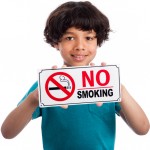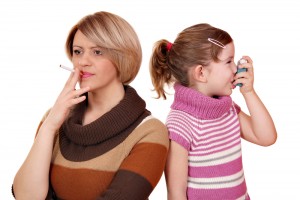
Annually 5.7 million deaths are attributed to smoking world-wide. Second-hand smoking is also associated with increased death rates and poor health outcomes. Since 1975, numerous countries and states have adopted anti-smoking legislation. Currently 16% of the world’s population are covered by smoke-free laws. The main target of this legislation has been to improve adult health outcomes but we can all breathe easier after Been and colleagues’ 2014 systematic review showed quite large benefits for children, too. Previous research has indicated a link between second-hand smoking and increased premature birth rates, decreased birth weights and higher incidence of asthma. Approximately 11 million children are born prematurely per year and these figures are increasing annually. As premature birth is associated with a variety of negative health, educational and cognitive outcomes, it is important to identify interventions that are effective in decreasing premature birth rates. There are also massive health and well-being costs associated with care and intervention for asthma. Been and colleagues’ 2014 systematic review aimed to assess the effectiveness of the introduction of smoke-free legislation on child health outcomes.

5.7 million deaths are attributed to smoking world-wide each year, while second-hand is also associated with increased death rates and poor health outcomes.
Methods
This article was a meta-analysis which assessed and summarised published material and registered unpublished clinical trials from 1975-2013. Strict Cochrane Effective Practice and Organisation of Care (EPOC) guidelines were followed. This increases confidence in the quality of the research studies included in the meta-analysis. For the purposes of this paper childhood was defined as less than 12 years-old although the authors included studies with older children if “most” were under 12 years old. Key outcome criteria were:
- Low birth weight (<2500g) and very low birth weight (<1500g)
- Preterm birth (generally classified as <37 weeks)
- Emergency asthma admissions or visits
There were also additional outcomes that were measured such as being born small for gestational age, the presence of upper and lower respiratory infections or the presence of chronic coughs. Eleven studies that investigated the impact of legislation on workplace/public-place smoking and included at least one measure of childhood health outcomes were identified. All but one included study was judged as being low or moderate risk of bias flowing Cochrane Effective Practice and Organisation of Care (EPOC) guidelines.
- The eleven studies that met the inclusion criteria were published between 2008-2013.
- These studies covered over 2.5 million births in total.
- Five studies were from the USA and Canada (state-wide smoking legislation) and six were from Europe (national smoking legislation).
- Bans varied in their approach, some covered bars and restaurants only, others covered workplaces or public places and some covered all three environments.

A recent study assessed the effectiveness of smoke-free legislation on child health outcomes (incl. low birth weight, preterm birth & emergency asthma admissions).
Results
- A 10.4% drop in premature birth rate (based on four studies, risk difference -10.4% [95% Confidence interval -18.8 to -2.0, p=0.016], I2 = 82.9%)
- A drop of 10% in hospital attendance because of asthma (based on three studies, risk difference = -10.1% [95% CI -15.2 to -5.0, p=0.0001], I2 = 14.6%)
- A decline of approximately -2% in low birth weight infants, however this was not statistically significant (based on four studies, risk difference = -1.7% [95% CI -5.1 to 1.6, p=0.31], I2 = 71.6%)
- The most beneficial outcomes were reported after comprehensive smoking bans that cover behaviour in many environments, rather than piece-meal interventions.
Important note! When scientists look at results of studies they often refer to statistical significance. This is a controversial term as it only tells us how confident we can be that the result was just because of chance. Statistical significance doesn’t tell us anything about how much of an impact an intervention had (in this case smoking bans) or how meaningful that impact is.

The results point at increased health outcomes for children (i.e. overall 10% reductions in preterm birth and asthma admissions) where there is anti-smoking legislation.
Strengths and Limitations
This paper summarises high quality research. The authors used a thorough search method to find relevant work for the paper.
- There may have been additional unmeasured factors in children’s environments that may have changed their outcomes rather than just the impact of anti-smoking legislation.
- Some studies had relatively small sample sizes.
- There were no studies from low or middle income countries included in the paper so we can’t be certain that these results are generalizable to countries with different cultural and economic climates where, for example, a ban on smoking in public could increase smoking in the home.
- The studies focus on measures of relatively young children’s outcomes, it would be interesting to see if there are any long-term changes in outcomes.
Implications of the findings
For public-policy makers: With increasing knowledge of the long-term outcomes following preterm birth and the costs of the treatment of asthma, anti-smoking legislation could be a cost effective way of addressing these issues. However, the authors state that the costs of the introduction of this type of intervention must be investigated in depth. For GPs and midwives: Overall, these studies have produced important outcomes. Although on an individual level the effects of anti-smoking legislation may be difficult to gauge, the effects on whole populations were sizeable for some measures, for example, the overall 10% reductions in preterm birth and asthma admissions. Therefore, a sensible approach for GPs and midwives is to recommend that expectant mothers do not smoke and avoid smoke-filled environments. For expectant parents: This paper shows that anti-smoking legislation is associated with increases health outcomes for children across large populations, for example in countries or states that ban smoking in public places. These data don’t guarantee that being in a smoke-free environment whilst being pregnant will ensure that babies are not born premature or will not have asthma. However, expectant parents in countries or states where smoking bans have been introduced should be reassured that their governments or policy makers are making good steps to improve the health of future generations.

A sensible approach for GPs and midwives is to recommend that expectant mothers do not smoke!
Link
Been, J.; Nurmatov, U.; Cox, B.; Nawrot, T.; van Schayck, C. & Sheikh, A. (2014). Effect of smoke-free legislation on perinatal and child health: A systematic review and meta-analysis. The Lancet, 383, 1549- 1560.